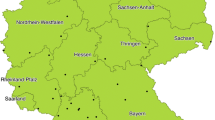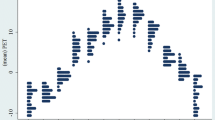Abstract
The aim of this study was to evaluate the relationship between weather conditions and daily emergency ambulance calls for acute coronary syndromes (ACS). The study included data on 3631 patients who called the ambulance for chest pain and were admitted to the department of cardiology as patients with ACS. We investigated the effect of daily air temperature (T), barometric pressure (BP), relative humidity, and wind speed (WS) to detect the risk areas for low and high daily volume (DV) of emergency calls. We used the classification and regression tree method as well as cluster analysis. The clusters were created by applying the k-means cluster algorithm using the standardized daily weather variables. The analysis was performed separately during cold (October–April) and warm (May–September) seasons. During the cold period, the greatest DV was observed on days of low T during the 3-day sequence, on cold and windy days, and on days of low BP and high WS during the 3-day sequence; low DV was associated with high BP and decreased WS on the previous day. During June–September, a lower DV was associated with low BP, windless days, and high BP and low WS during the 3-day sequence. During the warm period, the greatest DV was associated with increased BP and changing WS during the 3-day sequence. These results suggest that daily T, BP, and WS on the day of the ambulance call and on the two previous days may be prognostic variables for the risk of ACS.




Similar content being viewed by others
References
Abrignani MG, Corrao S, Biondo GB, Renda N, Braschi A, Novo G et al (2009) Influence of climatic variables on acute myocardial infarction hospital admissions. Int J Cardiol 37:123–129
Bakal JA, Ezekowitz JA, Westerhout CM, Boersma E, Armstrong PW (2013) Association of global weather changes with acute coronary syndromes: gaining insights from clinical trials data. Int J Biometeorol 57(3):401–408
Barnett AG, Dobson AJ, McElduff P, Salomaa V, Kuulasmaa K, Sans S, WHO MONICA Project (2005) Cold periods and coronary events: an analysis of populations worldwide. J Epidemiol Community Health 59(7):551–557
Bhaskaran K, Hajat S, Haines A, Herrett E, Wilkinson P, Smeeth L (2009) Effects of ambient temperature on the incidence of myocardial infarction. Heart 95:1746–1759
Breiman L, Friedman J, Olshen R, Stone C (1984) Classification and regression trees. Wadsworth, Belmont
Cherry N (2003) Actual or potential effects of ELF and RF/MW radiation on enhancing violence and homicide, and accelerating aging of human, animal or plant cells. Lincoln University. Human Sciences Department P.O. Box 84, Canterbury, New Zealand
Danet S, Richard F, Montaye M, Beauchant S, Lemaire B, Graux C et al (1999) Unhealthy effects of atmospheric temperature and pressure on the occurrence of myocardial infarction and coronary deaths. A 10-year survey: the Lille-World Health Organization MONICA project (Monitoring trends and determinants in cardiovascular disease). Circulation 100:E1–E7
Ebi KL, Exuzides KA, Lau E, Kelsh M, Barnston A (2004) Weather changes associated with hospitalizations for cardiovascular diseases and stroke in California, 1983–1998. Int J Biometeorol 49:48–58
Eldwood PC, Beswick A, O’Brien JR, Renaud S, Fifield F, Limb ES et al (1993) Temperature and risk factors for ischaemic heart disease in the Caerphilly Prospective Study. Br Heart J 70:520–523
Eichmeier J, Burger P (1969) Uber den einfluss elektromagnetisches strahlung auf die bismuthchlorid–fällungsreaktion nach Piccardi. Int J Biometeorol 13:239–256
Funk RH, Monsees T, Özkucur N (2009) Electromagnetic effects—from cell biology to medicine. Prog Histochem Cytochem 43:177–264
Gasparrini A, Armstrong B, Kenward MG (2010) Distributed lag non-linear models. Stat Med 29:2224–2234
Giertz HW (2010) Extremely low frequency electromagnetic energy in the air. J Atmos Sol-Terr Phys 72:767–773
Goerre S, Egli C, Gerber S, Defila C, Minder C, Richner H et al (2007) Impact of weather and climate on the incidence of acute coronary syndromes. Int J Cardiol 118:36–40
Hopstock LA, Barnett AG, Bonaa KH, Mannsverk J, Njolsad I, Wilsgaard T (2013) Seasonal variation in cardiovascular disease risk factors in a subarctic population: the Tromso Study 1979–2008. J Epidemiol Community Health 67:113–118
Hori A, Hashizume M, Tsuda Y, Tsukahara T, Nomiyama T (2012) Effects of weather variability and air pollutants on emergency admissions for cardiovascular and cerebrovascular diseases. Int J Environ Health Res 22:416–430
Houck PD, Lethen JE, Riggs MW, Gantt DS, Dehmer GJ (2005) Relation of atmospheric pressure changes and the occurrences of acute myocardial infarction and stroke. Am J Cardiol 96:45–51
Houdas Y, Deklunder G, Lecroart JL (1992) Cold exposure and ischemic heart disease. Int J Sports Med 13:S179–S181
Israelsson S, Tammet H (2001) Variation of fair weather atmospheric elecricity at Marsta Observatory, Sweden, 1993–1998. J Atmos Sol-Terr Phys 63:1693–1703
Jones SS, Thomas A, Evans RS, Welch SJ, Haug PJ, Snow GL (2008) Forecasting daily patient volumes in the emergency department. Acad Emerg Med 15(2):159–170
Kawahara J, Sano H, Fukuzaki H, Saito K, Hirouchi H (1989) Acute effects of exposure to cold on blood pressure, platelet function and sympathetic nervous activity in humans. Am J Hypertens 2:724–726
Kolesnik SA, Pikalov MV, Solovev SA, Chukin VV (2008) Physical principles of forecasting the characteristics of the ELF environmental electromagnetic background noise from the meteorological factors. Russ Phys J 51:980–985
Kriszbacher I, Boncz I, Koppán M, Bódis J (2008) Seasonal variations in the occurrence of acute myocardial infarction in Hungary between 2000 and 2004. Int J Cardiol 129:251–254
Kunst AE, Groenhof F, Mackenbach JP (1994) The association between two wind chill indices and daily mortality variation in the Netherlands. Am J Public Health 84(11):1738–1742
Kveton V (1991) Weather fronts and acute myocardial infarction. Int J Biometeorol 35:10–17
LaBounty T, Kim AE, Manfredini R, Fang J, Tsai T, Smith D et al (2006) The impact of time and day on the presentation of acute coronary syndromes. Clin Cardiol 29:542–546
Marchant B, Ranjadayalan K, Stevenson R, Wilkinson P, Timmis AD (1993) Circadian and seasonal factors in the pathogenesis of acute myocardial infarction: the influence of environmental temperature. Br Heart J 69:385–387
Marchant B, Donaldson G, Mridha K, Scarborough M, Timis AD (1994) Mechanisms of cold intolerance in patients with angina. J Am Coll Cardiol 23:630–636
McGregor GR, Walters S, Wordley J (1999) Daily hospital respiratory admissions and winter air mass types, Birmingham, UK. Int J Biometeorol 43:21–30
Mendoza B, Diaz-Sandoval R (2000) Relationship between solar activity and myocardial infarctions in Mexico City. Geofis Int 39(1):53–56
Mercer JB (2003) Cold—an underrated risk factor for health. Environ Res 92:8–13
Morabito M, Modesti PA, Cecchi L, Crisci A, Orlandini S, Maracchi G et al (2005) Relationships between weather and myocardial infarction: a biometeorological approach. Int J Cardiol 105:288–293
Morabito M, Crisci A, Grifoni D, Orlandini S, Cecchi L, Bacci L et al (2006) Winter air-mass-based synoptic climatological approach and hospital admissions for myocardial infarction in Florence, Italy. Environ Res 102:52–60
Morabito M, Crisci A, Orlandini S, Maracchi G, Gensini GF, Modesti PA (2008) A synoptic approach to weather conditions discloses a relationship with ambulatory blood pressure in hypertensives. Am J Hypertens 21(7):748–752
Muggeo VMR (2010) Analyzing temperature effects on mortality within the R environment: the constrained segmented distributed lag parameterization. J Stat Soft 32(12):1–12
Mustafic H, Jabre P, Caussin C et al (2012) Main air pollutants and myocardial infarction: a systematic review and meta-analysis. JAMA 307(7):713–721
Larcan A, Lambert H, Stoltz JF, Laprevote-Heuilly MC, Kempf JB, Lambert J (1982) Climatological parameters and acute vascular, neurological and cardiac accidents. Rev Epidemiol Sante Publique 30:343–354
Panagiotakos DB, Chrysohoou C, Pitsavos C, Nastos P, Anadiotis A, Tentolouris C et al (2004) Climatological variations in daily hospital admissions for acute coronary syndromes. Int J Cardiol 94:229–233
Peters A, Fröhlich M, Döring A, Immervoll T, Wichmann HE, Hutchinson WL et al (2001) Particulate air pollution is associated with an acute phase response in men (MONICA–Augsburg Study). Eur Heart J 22:1198–1204
Petralli M, Morabito M, Cecchi L, Crisci L, Orlandini S (2012) Urban morbidity in summer: ambulance dispatch data, periodicity and weather. Cent Eur J Med 7:775–782
Pressinger MA (1987) Mental processes and disorders: a neurobehavioral perspective in human biometeorology. Experentia 43:39–48
Sarna S, Romo M, Siltanen P (1977) Myocardial infarction and weather. Ann Clin Res 9:222–232
Shaposhikov D, Revich B, Gurfinkel Y, Naumova E (2014) The influence of meteorological and geomagnetic factors on acute myocardial infarction and brain stroke in Moscow, Russia. Int J Biometeorol 58(5):799–808
Spencer FA, Goldberg RJ, Richard C, Becker RC, Gore JM (1998) Seasonal distribution of acute myocardial infarction in the second National Registry of Myocardial Infarction. J Am Coll Cardiol 31:1226–1233
Sun Y, Heng BH, Seow YT, Seow E (2009) Forecasting daily attendances at an emergency department to aid resource planning. BMC Emerg Med 9:1. doi:10.1186/1471-227X-9-1
Villoresi G, Breus TK, Dorman LI, Iuchi N, Rapoport SI (1995) Effect of interplanetary and geomagnetic disturbances on the increase in number of clinically serious medical pathologies (myocardial infarct and stroke) [In Russian]. Biofizika 40(5):983–993
Wang H, Matsumura M, Kakehashi M, Eboshida A (2006) Effects of atmospheric temperature and pressure on the occurrence of acute myocardial infarction in Hiroshima City. Hiroshima J Med Sci 55:45–51
Wichmann J, Ketzel H, Ellermann T, Loff S (2012) Apparent temperature and acute myocardial infarction hospital admissions in Copenhagen, Denmark: a case-crossover study. Environ Health 11:1–12
WMO (1999) Weather, climate and health, WMO No. 892. World Meteorological Organization, Geneva
Wolf K, Schneider A, Breitner S, von Klot S, Meisinger C, Cyrys J et al (2009) Air temperature and the occurrence of myocardial infarction in Augsburg, Germany. Circulation 120(9):735–742
Wong HT, Lai PC (2012) Weather inference and daily demand for emergency ambulance services. Emerg Med J 29:60–64
Yakerson N (2002) On the correlation between wind speed, coarse aerosol concentration and the electric state in the ground atmospheric layer in semi-arid areas. Sci Total Environ 293:107–116
Ziegelstein RC (2001) Depression in patients recovering from myocardial infarction. JAMA 286:1621–1624
Acknowledgments
We acknowledge the contribution of Kaunas City ambulance involved in the registration of cardiovascular emergency admissions and the formation of the computer database.
Author information
Authors and Affiliations
Corresponding author
Rights and permissions
About this article
Cite this article
Vencloviene, J., Babarskiene, R., Dobozinskas, P. et al. Effects of weather conditions on emergency ambulance calls for acute coronary syndromes. Int J Biometeorol 59, 1083–1093 (2015). https://doi.org/10.1007/s00484-014-0921-6
Received:
Revised:
Accepted:
Published:
Issue Date:
DOI: https://doi.org/10.1007/s00484-014-0921-6




